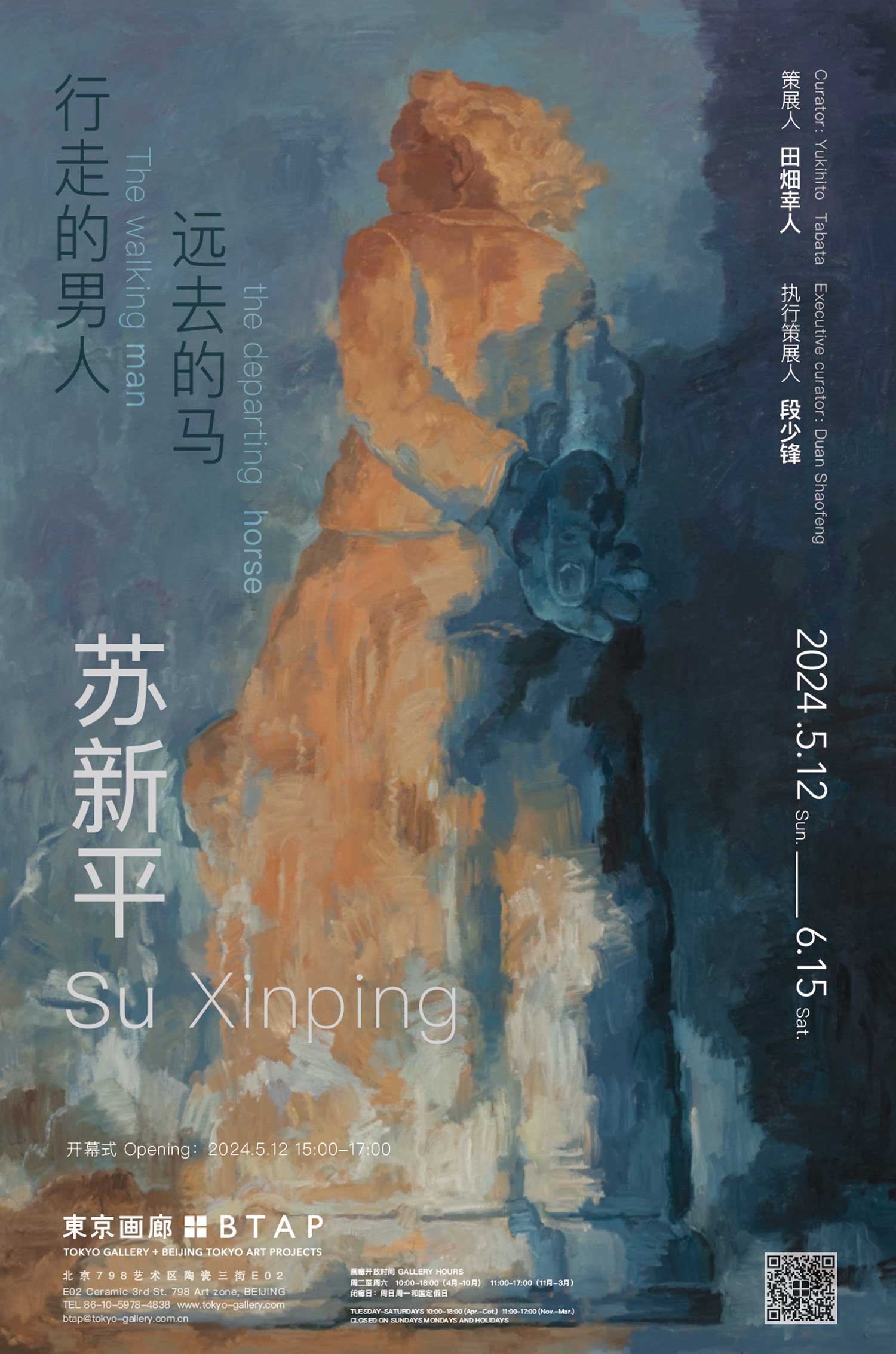展期 Period:
2024.5.12—2024.6.15
艺术家 Artist:
策展人 Curator:
执行策展人 Executive Curator:
地点 Venue:
新闻稿 Press Release:
東京画廊+BTAP(北京)将于2024年5月12日举办苏新平个展《行走的男人,远去的马》。
苏新平,1960年生于内蒙古集宁市,1977年入部队服兵役,1983年毕业于天津美术学院绘画系,毕业后在内蒙古师范大学美术系任教。1989年毕业于中央美术学院版画系,获得硕士学位,并留校任教,2014年至2022年任中央美术学院副院长,现为中央美术学院学术委员会主任、教授、博士生导师。
苏新平是一位上个世纪八十年代以来长期活跃于中国当代艺术界的艺术家,作为中国版画的领军人物为大家所熟知,其创作涉及油画,版画,影像,雕塑等。一直以来苏新平的作品中都关注于将空间作为母题,如其为艺术界熟知的关于草原空间的早期作品,九十年代,苏新平作为全球化的见证者和参与者,在其作品中表现当代人的生存状态,之后苏新平回归到空间与人的母题,在其作品中模糊了虚与实、具象和抽象的边界。在苏新平的作品中存在不同层次的空间关系,庞大的身躯和远处的风景与马构成多重的空间交叠关系,正如同苏新平一直以来处理自己与世界的关系,他既是艺术生态的参与者,同时却也时刻调整着自己和艺术生态各个环节的距离,他更希望自己是作为“我”的旁观角色。苏新平是一位追求个人真实的艺术家,正如同他在工作室的状态,和门外都市的喧嚣不同,苏新平在工作室构建了属于他自己的理想国。长期以来苏新平给人以距离感,正如同他绘画中的空间关系一样若即若离。
本次展览将集中展出十余件苏新平最新创作的油画和雕塑作品,是苏新平近年来创作的精选呈现,本次展览主题为《行走的男人,远去的马》,“行走的男人”这一形象近年来随着苏新平的大型雕塑的图像传播成为这个时代精神的象征之一,“远去的马”则是“行走的男人”之外艺术家内心世界的真实写照,他在心中再一次回到了艺术开始的地方以及理想主义的起源。本次展览是一次跨越时间的呼应,苏新平八十年代创作的作品《躺着的男人与远去的白马》是自己八十年代状态的写照,那么本次展览则是对于近年来苏新平艺术创作的一次回望。
马和人这种在苏新平作品中符号性的元素作为这次展览的主题,将苏新平一以贯之的自然观,“天”“地”“人”的母题通过多种材料呈现出来。对天地的敬畏和对自身的内省也正是苏新平绵长而厚重的艺术创作生命力的内核。如同本次展览策展人田畑幸人所说:通过苏老师的作品,我们强烈的感受到他在追问事物的本质,追问人为何物。
本次展览将持续到6月15日,欢迎您莅临参观。
Tokyo Gallery + BTAP (Beijing) will present Su Xinping's solo exhibition "The walking man, the departing horse" on May 12, 2024.
Su Xinping was born in Jining City, Inner Mongolia, in 1960. He was enlisted in the army for military service in 1977. He graduated from the Painting Department of the Tianjin Academy of Fine Arts in 1983, and upon graduation, he taught at the Fine Arts Department of the Inner Mongolia Normal University. In 1989, he received an MFA from the Printmaking Department of the Central Academy of Fine Arts and became a lecturer. From 2014 to 2022, he served as the vice-principal of the Central Academy of Fine Arts. He is currently the director of the Central Academy of Fine Arts Academic Committee, professor emeritus, and doctoral supervisor.
Su Xinping, an artist active in China's contemporary art scene since the 1980s, is recognized for his pioneering contribution to Chinese printmaking, whose media of expression span from oil painting, printmaking, and video to sculpture. Su Xinping's art practice adopts the physical space as a leitmotif, such as his early works on the grassland that accrued him notoriety in the art world. In the 1990s, Su Xinping, as a witness and participant of globalization, translated the living conditions of his contemporaries in his works before returning to exploring the sense of space, which explored notions of boundaries through the elusive and tangible, figurative and abstract spaces. There are various spatial relationships in Su Xinping's works; the prominent figures set against a distant landscape form multiple spatial overlapping relationships with the horse. As Su Xinping addresses his relationship with the world, he constantly adjusts his position in the art world through active participation. He prefers being the observer of oneself. An artist who pursues his reality, isolated from the hustle and bustle outside of his studio door, Su Xinping prefers building an ideal country inside, and this sense of space and distance is synonymous with the spatial relations in his works on canvas.
This exhibition presents Su Xinping's ten latest oil paintings and sculptures from recent years. The exhibition " The Walking Man, The Departing Horse" highlights the two iconic images of the artist's practice. The "Walking Man," what the artist considers the symbolic ethos of our time, widely popularized through his large-scale sculpture, and the "Departing Horse" embodies the artist's inner world, one that allowed him to return to the origin and source where art and ideals began for him. This exhibition resonates with Su's 1980s iconic piece, "Sleeping Man, Departed Horse," portraying his state of being in the 1980s. This show offers a retrospective take on Su Xinping's art practice in recent years.
Horse and man, the two symbolic elements in Su Xinping's works, resonate with the artist's ongoing view of nature and convey his subjects of "heaven," "earth," and "man" through a variety of materials. Su's reverence for the heavens and the celestial and his introspection of the self are the core of Su Xinping's lasting and diverse artistic vitality. As the curator of this exhibition, Yukihito Tabata, says, "Through Mr. Su's works, we get a strong sense of his inquiry about the nature of things and what it means to be human. "
This exhibition will be on view until June 15th, and you are welcome to visit.

